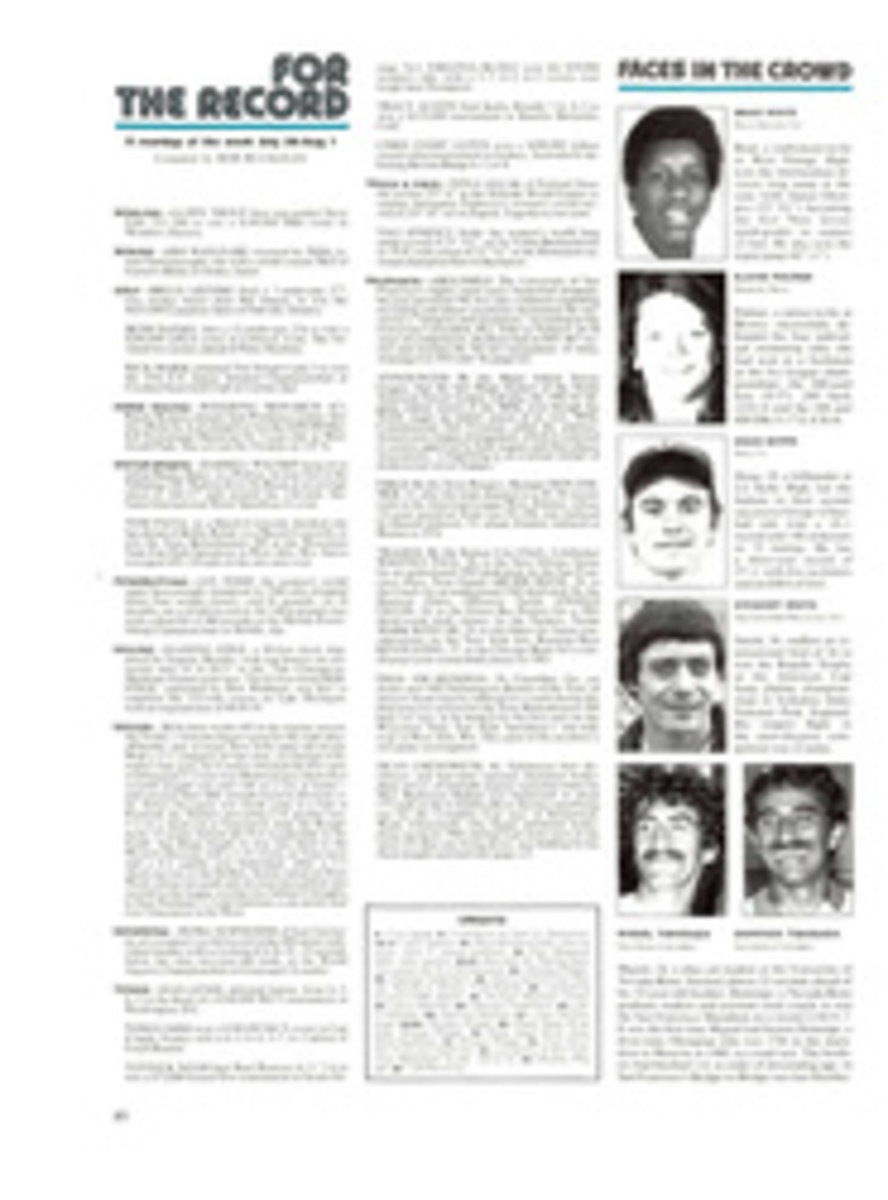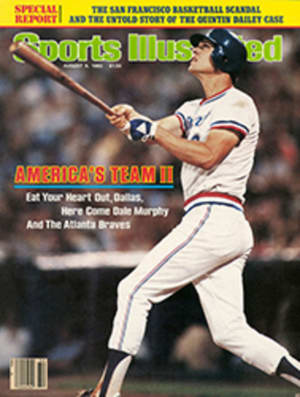
Will You Come Home, Bill Walton?
Bill Walton played basketball before a paid crowd last Saturday night for the first time in almost two years. It was in a charity game in Las Vegas, and there was considerable cynicism, echoing the comment of Seattle SuperSonic Guard Fred Brown, who asked after one such attempt a couple of years ago: "How many times has Bill Walton come back? He's just like Frank Sinatra. Makes as much, too." But a lot of people were unabashedly rooting for Walton.
Just 10 days after Old Blue Eyes had closed out a week-long gig at Caesars Palace, Player-Coach Walton brought his suspect left foot to the hotel's Sports Pavilion. The 2,400 spectators who saw him lead a UCLA alumni team against a similar bunch from the University of Nevada-Las Vegas knew that the 6'11" center for the San Diego Clippers, with whom he signed a six-year, $4 million contract three years ago, couldn't possibly have been in top form. But he did have 24 points, 21 rebounds, three assists, five blocks, two steals, three dunks, countless intimidations and exhortations and no discernible limp in 36 intense minutes as UNLV won 142-135. With :48 left in the third quarter, Walton even slammed home the business end of a lob pass for old time's sake. And he did all this only 19 months after his doctors, Ernie Vandeweghe and Tony Daly, all but said he'd never play again.
Could Old Red Head really be back? "Only time will tell," he said before the game. "To my own discredit I've tried to do too much too soon in the past. This is going to take patience and hard work. I'm elated that I can play at all. Obviously an NBA season would be a culmination of that work, but I'm not in a position to say it's going to happen."
Nor are his doctors—though they should get the credit if it happens. Walton was born with a left heel bone that prevents his foot from turning in or out, which placed extraordinary pressure on the ball of his foot. In 1978, while playing for the defending NBA champion Trail Blazers, he developed a tumor in his right foot that forced him to overwork his left. When the ball of his left foot wearied of the stress, it would pass the shock along the top of the foot to the navicular bone, which is about the size of a marshmallow. Four times his navicular has broken. "It's as if a geologist repeatedly tapped a rock with a hammer," Dr. Vandeweghe says. "Eventually it'll crack."
It was all the two doctors could do to correct the arch problem so that Walton could lead his everyday life without pain. In January 1981 Dr. Daly and podiatrist Dr. F.W. Wagner reshaped the foot's bone structure. Just before enrolling in Stanford Law School, Walton had another operation. It left him with a foot that at least looked normal. "There wasn't a tremendous amount of therapy to do after that because most of the August surgery just involved cutting away bone," Walton says. "It was a matter of rest, walking and letting new bone surface smooth out and soft tissue heal up. I did all the sports I've always enjoyed—cycling, running, soccer, Frisbee, tennis. And I played in a number of pickup games over the winter at school."
In June he ventured up from his home in San Diego to Loyola Mary-mount's new gym in Los Angeles once a week to play full-court with the likes of 6'11" ex-UNLV Center Lewis Brown, 7'3½ former Bruin Mark Eaton and Dr. Vandeweghe's 6'8" son, Kiki, the Denver Nugget.
"There's still some conditioning pain and I have to get the kinks out," he says. "Most difficult are quick-reaction plays—rebounding and defense—and plays that involve timing. But at this point I'm able to forget about the foot, which makes playing so much fun."
For the fifth UNLV Community Roundball Classic, the Rebels brought back Reggie Theus, Jackie Robinson, Glen Gondrezick, Flintie Ray Williams and Sam and Robert Smith, among others. The Bruins fielded Walton, Roy Hamilton. Henry Bibby, David Greenwood, Mike Sanders, Vandeweghe fils, Eaton, and beach volleyball maven and longtime Walton buddy Greg Lee.
Most of the alumni took part in the requisite pregame razzing about affiliations, old-school and otherwise. Walton told how he decided on the Bruins' lineup: "I'll start the five who played on the most national championship teams."
Rebel Alumni Captain Theus struck back when someone asked Walton if his appearance would only be token. Theus answered for him. "Well, most of the players are black..."
A laughing Walton clarified matters: "My appearance will be token in the sense that Reggie spoke of, but not in terms of my time on the court."
Walton twice brought down the house, once on the aforementioned dunk and earlier when he cleanly spiked a Robinson fast-break layup attempt. "Jackie would've torn the rim down," Theus said after the game. "It takes incredible timing to block a shot like that."
When Walton made his reputation at UCLA, his forte was his mobility, quickness and enthusiasm. "He looked like he was moving well," Theus said. "His shot looked good and, as far as the mechanics are concerned, he's ready to play, but I think he got a little winded."
Indeed, Walton got only six points in the second half, and, with the score at 135-135 with a minute to play, he looked particularly tired as UNLV pulled away to win. That was probably from chasing the forwards he was matched against. Most of the night, either 6'8" Eddie McLeod or the 6'6" Gondrezick played center for UNLV, and when they took him outside and tried to blow past him, he appeared a half-step slow.
"You'd look slow too if you were 6'11" and had to guard those guys," Kiki Vandeweghe said. "Bill's the only center in the league who could've played against guys who are really forwards."
For much of the week, though, it looked as if Walton might be a no-show. He first was asked to sign a release form waiving San Diego's obligation to pay him for any games he might miss because of an injury suffered at Las Vegas. The 29-year-old Walton, who once lived his life with the same recklessness with which he plays basketball, didn't want to jeopardize the three years' salary San Diego still owes him.
But by dinnertime Thursday a compromise had been reached. "I'd always planned on being here," Walton insisted.
"I don't think he's necessarily more cautious now," Lee says. "But he's aware of all the legal ramifications of what he does." And since March 11, 1980, his last NBA regular-season game, Walton has led the league in litigation.
There's the $5.6 million suit Walton filed against Portland team physician Robert Cook, which was settled out of court in June; and the millions former San Diego owner Irv Levin wants from Walton, Daly and Vandeweghe because, Levin claims, they should have known and told him about the congenital problem in Walton's left foot before he, Levin, signed Walton. That suit is still pending. And then there's the $12.5 million suit the Clippers filed against Lloyd's of London and the Home Insurance Co. when the firms balked at paying the Clipper claim regarding Walton, which was settled with the Clippers getting the $1.25 million value of the policy but not the $11.25 million in punitive damages.
There's no timetable for the comeback, but the team expects he'll be at training camp in two months. "It's not a question of motivation," he says. "Just common sense. One game isn't going to determine whether I'll make it. But if I didn't give up hope 2½ years ago, I'm in no position to give up hope now, when I'm infinitely better off."
Want an omen? Try Sunday, 3 a.m., a blackjack table in the casino at Caesars. Walton departs with heavier pockets and a lighter step. "I'm gonna buy my wife a new pair of shoes," says the man with the new left foot.
PHOTO
RICHARD MACKSON
His uniform doesn't say Theus, but Walton knows it's Reggie's shot that he's rejecting.

